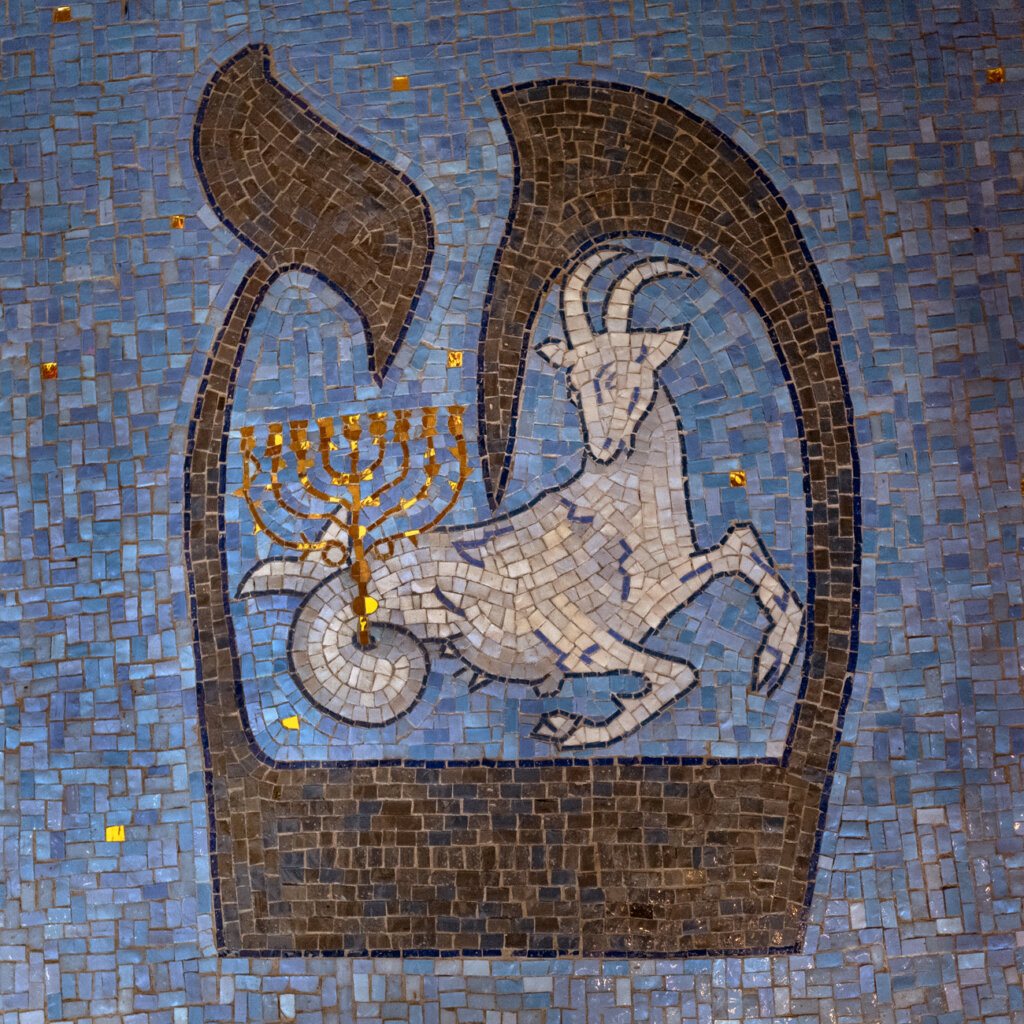In an Eldridge Street mosaic, a reminder of a great Jewish artist
Mark Podwal, who died at 79, wanted people to see one of his last major works

Mark Podwal’s mosaic, in the vestibule to the sanctuary at Eldridge Street. Courtesy of the Museum at Eldridge Street
Sometimes I let my inbox get away from me. Never have I regretted it more than when I failed to respond to a message from Aug. 23 from the artist Mark Podwal.
“With your interest in Jewish art, I think you would appreciate my new Jewish Zodiac mosaic floor recently installed at the Museum at Eldridge Street even if you are not interested in writing about it,” Podwal wrote to me. (I had previously reviewed his Jewish Bestiary, a catalog of creatures I revisit often.)
Podwal attached a link to photos, but noted that they “do not do the mosaic justice.”
I’m pretty busy, but Podwal, who died Sept. 13 at the age of 79, was busier. A prolific artist, author and a working dermatologist on the faculty at NYU, he was the sort of polymath who is increasingly rare. I only met him once, but he remembered me.
The occasion was a May 2023 exhibit at Eldridge Street, the 19th-century synagogue on the Lower East Side, where he was showing his reinvention of woodcuts from the 16th-century text the Sefer Minhagim, or Book of Customs. Podwal, as was his own custom, seized on these historical images and updated them for a modern audience.
To a woodcut detailing the hasty matzo-baking of the fleeing Israelites, he added a microwave. To a scene of a bris he inserted a giant, Monty Python-esque hand descending from the heavens with a scalpel.

Podwal was wearing a rosette from the French Ministry of Culture, where he was an officer of the Order of Arts and Letters. Per his request, Mozart was playing in the background. He patiently answered my questions, detailing for me the rabbinic sources sources he drew from to modernize these centuries-old artworks. (The curator told me his full notes didn’t fit the wall text; I was given a book that was more thorough.)
Toward the end of our talk, I asked him what he thought of my writeup on his bestiary in 2021. After some prodding he admitted he was a little upset that my review expressed disappointment that his rendering of the Leviathan, said to eat a whale a day, looked a lot like a regular fish. He said that I failed to note that the fish was encircling the whole earth.
His was a valid critique. I was ungenerous.
The same couldn’t be said for him. He wanted to give me a silkscreen print, and I had to decline (we can’t accept gifts from sources).
Podwal’s work was itself a gift. You could see it in the Metropolitan Opera gift shop (a true Mozart fan, he designed posters for seven of his operas), in synagogues in the Czech Republic (he was perhaps proudest of his textiles for the Altneuschul there) or accompanying the words of Elie Wiesel. And, he told me as I left Eldridge Street, it would soon appear on the floor above us, in the vestibule to the sanctuary.

He gave me printouts of the zodiac mosaic, where his great beasts wrangled with Hebrew letters. They are typically vivid in their color — a later development for Podwal, whose early art in editorial cartoons for The New York Times’ op-ed page was in black-and-white.
“Even though it’s a mosaic, it really looks like he painted it,” said Podwal’s son Ariel, who I spoke with about the floor and his father. “It looks like his lines and his hand.”
To install the floor, two artisans from Progetto Arte Poli came in from Verona, Italy. Podwal visited a few times to observe before the unveiling in June.
“I’m really glad he was able to see it come to fruition,” Ariel Podwal said, adding that Eldridge Street was a particularly meaningful site for his father, who grew up in New York City.

Like so much of Podwal’s work, the mosaic is steeped in research and tradition and an added sense of whimsy. The zodiac was a frequent motif for mosaics in ancient synagogues, but this floor takes its own spin on the iconography, pairing the star signs with their corresponding Hebrew month and its first Hebrew letter. He represents Gemini not with human twins, but the twin tablets of the law, which were revealed in the month of Sivan.
Libra (Tishrei) has its scales of justice weighed with a shofar in one basket, signaling the judgment of Yom Kippur. Pisces — for Adar — sees two fish swimming in an aleph. The fish are a symbol of good luck. Their heads are hamantaschen.
The imagery strikes first, but prompts questions. Podwal was always eager to explain — and bring citations. The ram of Aries hugs the nun, defensively, because, in the Pesikta Rabbati, it says the Temple couldn’t be destroyed in the month of Nisan. (That month’s sign is a ram, a reminder of the ram sacrificed in Isaac’s stead in the Akedah.)

Paying a belated visit, close to the Jewish new year, I was drawn in at the stairs to the glint of the tiles — the blue field of the floor: light blue, dark blue, a shade resembling the sacred blue of tekhelet.
In between the zodiac creatures, gold flecks glint, complementing the glass panes of the doors leading to the sanctuary and in conversation with Kiki Smith’s rose window, the other new feature of the historic synagogue.
In person, details emerge: the burning temple in the sign for Leo’s mane, the dreidel on the end of the Sagittarius arrow.
With the mosaic, tour groups now receive a lesson on the Jewish months and the symbolism, creating the kind of learning opportunities Podwal so valued. But explanation and history can only enrich so much. The images, and the colors, taken from matte acrylic and colored pencil on paper, shine with their own light.
He was right, of course. Photos didn’t do the mosaic justice.
Mark Podwal’s mosaic can be seen at the Museum at Eldridge Street.
























